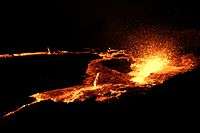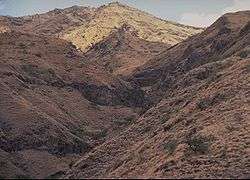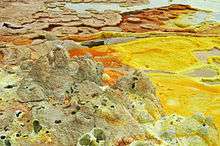Danakil Depression


The Danakil Depression is the northern part of the Afar Triangle or Afar Depression in Ethiopia,[1] a geological depression that has resulted from the presence of three tectonic plates in the Horn of Africa.
Geology
The Danakil Depression lies at the junction of three tectonic plates and has a complex geological history. It has developed as a result of Africa and Asia moving apart, causing rifting and volcanic activity. Erosion, inundation by the sea, the rising and falling of the ground have all played their part in the formation of this depression. Sedimentary rocks such as sandstone and limestone lie unconformably with basalt which resulted from extensive lava flows.[2]
Location
The Danakil Depression is a plain, some 40 by 10 km (25 by 6 mi), lying in the north of the Afar Region of Ethiopia, near the border with Eritrea. It is about 125 m (410 ft) below sea level and is bordered to the west by the Ethiopian Plateau and to the east by the Danakil Alps, beyond which is the Red Sea.[3] This area is referred to as the cradle of hominids after Donald Johanson and his colleagues in 1974 found the famous Lucy Australopithecus fossil, which has been dated 3.2 million years old.[4]
Features

The Danakil Depression is the hottest place on Earth in terms of year-round average temperatures. It is also one of the lowest places on the planet (100 m below sea level[5]), and without rain for most of the year. Here, the Awash River dries up in a chain of salt lakes never reaching the Indian Ocean.[6]
Mount Ayalu is the westernmost and older of the two volcanoes at the southern end of the Danakil Depression. The other active volcano, Erta Ale, is one of several magma crater lakes bubbling from the Earth's core. Additionally, the area contains the Dallol sulfur springs, or hot springs. These wet environments at the Danakil Depression are being investigated to help understand how life might arise on other planets and moons.[5] Any microorganisms living here will be extremophilic microbes of a major interest to astrobiologists.[5]
See also
References
- ↑ Beyene, Alebachew & Abdelsalam, Mohamed G. (2005). "Tectonics of the Afar Depression: A review and synthesis". Journal of African Earth Sciences. 41 (1–2): 41–59. doi:10.1016/j.jafrearsci.2005.03.003.
- ↑ Thomas Schlüter (2008). Geological Atlas of Africa: With Notes on Stratigraphy, Tectonics, Economic Geology, Geohazards, Geosites and Geoscientific Education of Each Country. Springer Science & Business Media. pp. 88–89. ISBN 978-3-540-76373-4.
- ↑ J.L. Melvin (1991). Evaporites, Petroleum and Mineral Resources. Elsevier. pp. 44–45. ISBN 978-0-08-086964-3.
- ↑ "Danakil Depression". Insideethiopiatours.com. Retrieved 2013-12-10.
- 1 2 3 "Hydrothermal Systems Show Spectrum of Extreme Life on Earth". Europlanet. Astrobiology Web. April 26, 2016. Retrieved 2016-05-01.
- ↑ "Africa's Danakil Desert - National Geographic Magazine". Ngm.nationalgeographic.com. Retrieved 2013-12-10.
External links
| Wikivoyage has a travel guide for Danakil Depression. |
Coordinates: 14°14′30″N 40°18′00″E / 14.2417°N 40.3°E